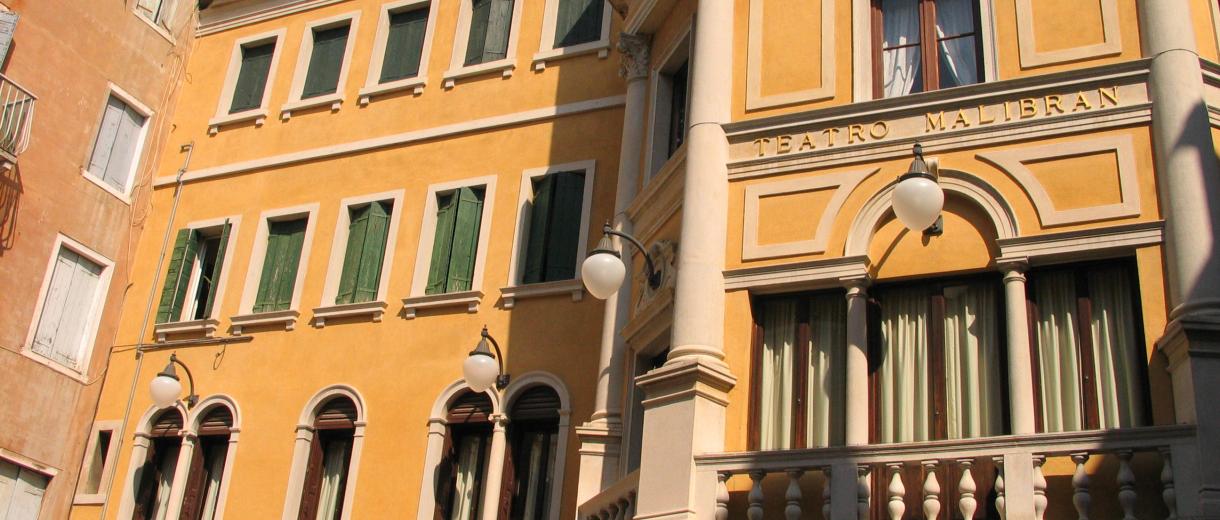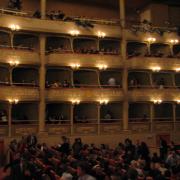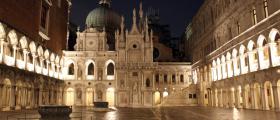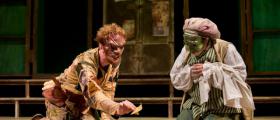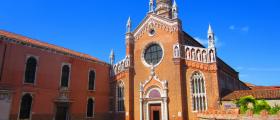The Malibran Theatre
The Malibran Theatre was built by Grimani brothers from Santa Maria Formosa at the end of 1677 the works took only 4 month and it was erected in place of the old house of Marco Polo.
This is testified also by the close Corte del Milion. Since the beginning the idea was to make of it the scenery of the main lyric representation of the city and soon become known as "the biggest, the most beautiful and the richest theatre of the city" (J.C. de Cramailles, 1683) in spite there were already 18 theatre in the city.
Not many traces left of the original project, the few witnesses founded reveals that it const with 5 rows of 33 box each disposed as an horseshoe. During 1700 it was enlarged to increase the occupancy, every row was rebuilt with 40 boxes each at appear now as an U shape.
The theatre was restored again, not really properly, in 1756, there start slowly its decadence as elected place, it was also proposed to reshape it as the original project to take it back to its splendour, to make it better accessible and to help Sthe self representation needs of the middle class of that epoch, however the surrounding urbanity tissue made it impossible to do, remaining secluded, as usually were the ancient Venetian theatres.
Neither the late restoration made in 1919 could bring back the theatre to the initial grandeur, the project signed in 1919 by Ing. Donghi was mainly based on the pre existing structure taking chance from the oblong shape of the building to build two galleries in front of the scene, to compensate the extended length the hall was enlarged, this determined the building of suspended corridors over the adjacent canal San Giovanni Grisostomo and the lateral street.
After the late renewal, the activity of the Malibran Theatre, whose name was a tribute mad in 1835 in honour of the great singer that sang the “Sonnambula” in the thatre itself, went on all along the first half of the 20th century, with operas, operetta, and cinema shows.
The Venice municipality purchased the theatre in 1992, a new season started, the roof has been restored, this supposed the beginning of a great project of a global restoration , modifying the structures, enlarging galleries and boxes giving more power and strength to the scenery.
This majestic project was abandoned favouring the original project, when the Fenice theatre burned down that we all still remember the use of Malibran become indispensable, the project was approved quite rapidly.
The project included also the enlargement of the orechestral site with the building also of an underground tank to keep away the danger of high tide that specially during winter times or under certain unfavourable meteorological conditions hit the city.
During the excavation some relevant archaeological find, dated 5th century, and the remaining walls of the ancient house of Polo family come to light.
About the inner decorations of the Malibran, those has been carefully restored as per the Donghi project, an important contribute to the recover of one of the most important historic theatre of Venice, finally returned back to the city and able to host 900 people, come from the Association “Friends of La Fenice” that provided the conservative restoration of the magnificent curtain, an opera by Giuseppe Cherubini enriched with Gold and Silver lines.

